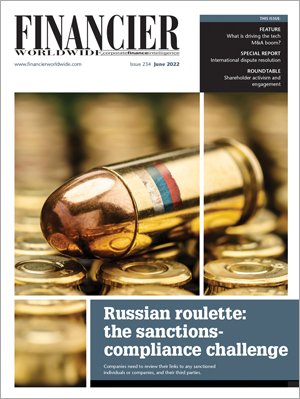Women in leadership post-COVID-19: building a new paradigm
June 2022 | FEATURE | BOARDROOM INTELLIGENCE
Financier Worldwide Magazine
While progress toward a greater representation of women in senior leadership roles has been significant in recent years, research shows that progression has slowed, with the emergence of the coronavirus (COVID-19) pandemic further unbalancing the uneven field women were already playing on.
One area where the impact of the pandemic on women’s leadership has been particularly evident is in the composition of COVID-19 government task forces around the world, where men outnumber women by three to one – a disproportionate representation that many expect will hamper women’s recovery from the pandemic and perpetuate gender divisions.
According to the UNDP’s ‘COVID-19 Global Gender Response Tracker’, which analyses government pandemic policies, women, on average, still make up only 24 percent of members among 262 government COVID-19 task forces examined across 137 countries. Moreover, in 10 percent of task forces, women are excluded from leadership at even higher rates, leading only 18 percent of 414 task forces across 186 countries.
“While a number of high-profile women leaders have been in the spotlight for their impactful COVID-19 responses, women are significantly underrepresented in both membership and leadership of COVID-19 taskforces,” says Raquel Lagunas, global director of gender equality at the United Nations Development Programme (UNDP). “The pandemic has also shown just how deep and pervasive gender inequalities are in our political, social and economic systems.
“We must fight back against the gender backlashes we are seeing globally, work to shift the power balance and to transform discriminatory social norms that fuel these inequalities,” she continues. “Without women in senior decision-making roles, measures taken by governments are more likely to ignore women’s needs and it could further exacerbate the unequal recovery opportunities from the pandemic, which is already threatening to reverse decades of progress on gender equality.”
Potentially adding fuel to the fire is further analysis by the UNDP – ‘Tackling social norms: a game changer for gender inequalities’ – which reveals that around 90 percent of people globally hold some sort of bias against women in areas such as politics, economics and education.
“Including and supporting women, as well as the organisations and networks that represent them, in decision-making processes will ultimately shape the post-pandemic future and help build a new paradigm of female leadership.”
Even so, with a flexible approach and leadership development initiatives providing greater opportunities to advance female talent, organisations that take action to support women leaders in a post-pandemic environment can gain a significant business advantage and help to elevate women in leadership around the world.
Change from the bottom up
Post-COVID-19, the consensus is that the world will never be the same again and needs to adapt. In the view of David Oppenheimer, director of the Berkeley Center on Comparative Equality and Anti-Discrimination Law, the pandemic represents “an enormous chance to create opportunities for change”, with national, regional and international policymakers needing to lead the transformation from the bottom up.
That said, a report by the UNDP and the University of Pittsburgh – ‘Gender Equality in Public Administration’ – found that, while there has been progress on women’s representation overall, persistent gaps remain. Indeed, women continue to hit a glass ceiling and glass walls that stop them from advancing to positions at the highest levels of power and influence, including in the worldwide COVID-19 response.
In a bid to help shatter these glass ceilings and glass walls and help shift the balance of power and boost women’s participation in leadership, the report provides five practical recommendations: (i) strengthening and pushing for new laws, including through quotas and temporary special measures; (ii) improving the availability of gender data; (iii) leveraging and building new partnerships; (iv) promoting synergies across the gender equality agenda; and (v) changing institutions.
“Work toward gender equality also includes capacity-building, training and professional development for women, as women may have less access to these opportunities,” adds Ms Lagunas. “Such training can enhance women’s skills but can also improve visibility and create opportunities for networking and mentorship.”
Power to change the world
Including and supporting women, as well as the organisations and networks that represent them, in decision-making processes will ultimately shape the post-pandemic future and help build a new paradigm of female leadership.
“The COVID-19 crisis reiterated how women’s leadership and agency have the power to change the world,” contends Ms Lagunas. “Women have been at the forefront of the pandemic response and some of the most effective national responses to the crisis have come from women leaders.
“Women have demonstrated new models of leadership based on care, solidarity and transparency,” she concludes. “With the pandemic having placed unprecedented challenges on governments and their citizens, effective decision making in public institutions and responsive and innovative public services are more important than ever.”
© Financier Worldwide
BY
Fraser Tennant


